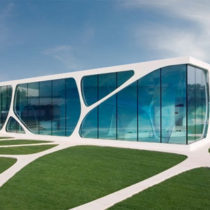Landscape Architecture for Landscape Architects › Forums › GENERAL DISCUSSION › Professional Porfolios
- This topic has 1 reply, 6 voices, and was last updated 13 years, 11 months ago by
 nca.
nca.
-
AuthorPosts
-
September 6, 2011 at 9:04 pm #160593
 Zach WatsonParticipant
Zach WatsonParticipantI have spent quite a bit of time looking at various Landscape Architecture firms and the portfolios on their websites. I find it interesting that while I have received advice from professionals that I need to show my critical thinking ability, in my portfolio, to show to them how I work through a design, I don’t think I have ever seen a Landscape Architecture Firm show their critical thinking ability in their portfolio. Quite often they will show a hand graphic or two along with pictures of their finish project.
My question to professionals out there is: Is your portfolio created just for the purpose of showing the ascetics of your work? Is there no time or budget to put together a portfolio which shows the critical thinking ability of the firm? Or, which I think is more likely the case, do firms get so little traffic to their website, because of the source of their work, that there is no reason to put that much work into showing the critical thinking ability of their firm?
Just food for thought.
Personally I would like to see a professional firm put together a website showing the critical thinking ability and the design process that they work through on a project, so I could get an idea of how they see things, how they approach a design conflict, and simply to see how the firm works through the design process.
September 6, 2011 at 11:32 pm #160600 ncaParticipant
ncaParticipantSimple answer:
Know your audience. In most cases professional offices are marketing to clients who are typically most impressed by the finished product, ie built projects.
Individuals are marketing themselves toward professional offices who are most impressed/concerned with design ability.
Example: Try taking your academic coursework out to try to sell work…People will look at you like have two heads. The average client probably doesn’t ‘get it’ to begin with. What they get is flowers, bushes, roads, sidewalks, grass, and rocks.
I would take this a step further by saying that a lot of corporate firms are most concerned with the candidates ability to please clients and eventually sell work over quality of design or creative prowess.
Food for thought.
September 7, 2011 at 12:10 am #160599 Andrew Garulay, RLAParticipant
Andrew Garulay, RLAParticipant… and others simply want to know how much back room production you can put out before they use you up and replace you with the next one at an intern pay rate.
September 7, 2011 at 6:00 am #160598 Geoff PicklesParticipant
Geoff PicklesParticipantI think that most clients wouldn’t understand much of the design process and what it involves, maybe the reason why they hire a professional in the first place.I actually found that most clients can’t or never fully understand drawings but that’s another subject. Most potential clients would be more impressed by the pictures of completed work that they like rather than the “philosophy” aspect. I think if a good photo thats shows some aspect of what they are looking for is better than a long explanation of how you intend to deliver the end result.
September 7, 2011 at 11:46 pm #160597 Zach WatsonParticipant
Zach WatsonParticipantI guess my mind just goes back to a firm that an Architecture friend of mine brought to my attention. B.I.G. (http://www.big.dk/) While I know that Building Architects work differently, I love some of their simple diagrams that they have on their website. If you click on just about any project they have on their webpage and scroll through the project there is always at least 3 images/diagrams relaying a some information about how the project works. They are not burdensome and thinks you can understand in just a 2-5 second glance. Now I understand that there is much more understanding that goes into a project than just 3 diagrams but it helps others to see some of the thought behind the design. I think it helps others to understand that designers don’t just ‘make things look pretty’.
September 8, 2011 at 3:00 am #160596 Zach WatsonParticipant
Zach WatsonParticipantI not sure where all of their funding comes from, I just enjoy looking at their site from time to time :). As far as your second question, I have heard someone say, great work blends seamlessly into it’s surroundings. With that context I would have to answer, yes great work should be explained. It should be explained not necessarily so that the designer get the recognition but so that people don’t just think it’s easy and simple.
My foundation of my thought is just this, If we always complain about our industry not getting its due respect for what we bring to the table, then shouldn’t we be blaming ourselves for the lack of understanding when we can’t explain in simple diagrams the big idea (or importance of our decision making) of the project? If we can’t explain it simply and visually show it, it is going to be very difficult to show others the significance of what we bring to the table.
September 8, 2011 at 3:29 am #160595 Steve BurkelParticipant
Steve BurkelParticipantThat website is truly inspiring. What a great visualization of a step-by-step demonstration of their design process– all without cluttering the images with un-needed text. As a concept-driven designer, I really see the importance of SHOWING the client WHY your design makes sense. So that it doesn’t just seem like it came out of left field— no matter how visually stunning the graphics may be, it won’t mean anything to the client can’t understand it.
September 8, 2011 at 4:01 pm #160594 Tosh KParticipant
Tosh KParticipantMy experience is that the portfolio sent to specific clients contain more info relevant to the client’s expectations- the websites are more glossy; younger firms will have more conceptual stuff (BIG’s principals are in their 30s I think), as they spend a lot of unbilled hours working on projects so that they might land projects in the future that follow along that line of thought (CMG I think shows some more diagrammatic work).
Stuff that we show in our school portfolios comes up in client interviews and in packages that go back and forth btw professional offices (engineers, building architects, etc). It’s more useful there.
-
AuthorPosts
- You must be logged in to reply to this topic.


